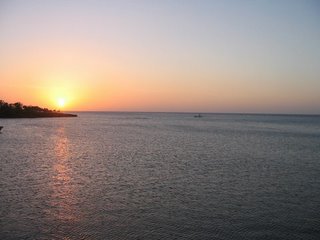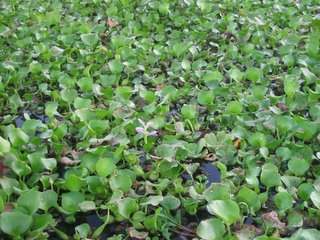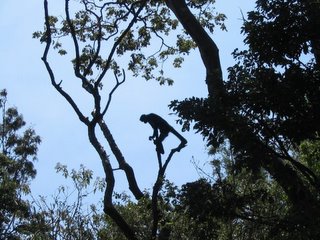I haven't really expanded on Roatán beyond diving options (or, in my case, the lack thereof). So, after spending just over one week there I thought I would give you a quick review of the West End and area.
In general, you don't
really feel like you are in Honduras when you are on Roatán. The islands have a mostly English (mostly pirate) history, and are predominantly English-speaking. I was able to watch plenty of Olympic hockey, as games were aligned perfectly with
siestas at the hottest parts of the day.
There are now two ATM's in the West End, so you don't need to show up with a fat wallet. The BAC is easy to find, and the second is in Coconut Tree Grocery. Neither are accessible after 9PM.
 Best Swimming:
Best Swimming: In the West End, the double-dock on Half Moon Bay is best (see photo at left). There are also good spots on the beach between West Bay and West End. If you want to swim in West Bay, the beautiful 4km walk takes under an hour. I spent most of my time near the rocks at the far end of the West Bay beach, because it tends to be a bit less crowded with the resort-goers.

Note that the walk to West End (shown here) is not as unsafe as Lonely Planet makes it out to be - I met women who walk it daily for exercise, on their own.
Best Snorkeling: The rocks on the west side of Half Moon Bay in the West End. West Bay is supposedly better, but I saw more types and number of aquatic life in Half Moon Bay. If you are a good swimmer, head beyond the shallows and into deeper water off Lighthouse Point - this is where I saw a turtle and some puffer fish. Keep your eye on the boats, and note that the west side of Lighthouse is quite shallow. Get your gear from Native Sons - for L95, you are in (mostly) new gear for the entire day.
Best Espresso: The restaurant at West End Divers and the one immediately to its right have the best espresso, but the latter is half the price (L30 versus L15). And while you are sipping on cheaper espresso, you can enjoy a much nicer view from the higher patio.
Best Accommodation: Chilli's Place. I stayed at Milka's, and it was a great deal. Still, I could have paid L40 (three bucks) more per night and enjoyed the wood cabins, numerous hammocks, and garden atmosphere at Chilli's. Chilli's shared kitchens are also equipped with more and better kitchen wares, while Milka's was terrible; I could have saved the higher room rate with better cooking options. The rooster factor at Milka's is also a concern, moreso if you sleep lightly.
Best Pub: Sundowners, but it is only open to 10PM. Note that I am not basing my decision on the fact it is Canadian-Owned. After 10, head for the Purple Turtle.
Best Dive Shop: Native Sons. There is a reason why they are so busy. All divers I spoke to raved about them.
Best Beer: Salvavida, although the Port Royal Export label almost reads Port Royal 'EH-Port'.























